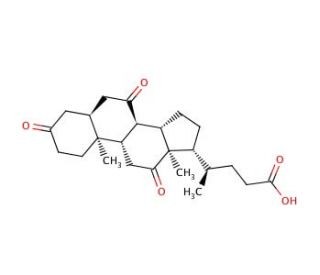
| 规格 | 价格 | 库存 | 数量 |
|---|---|---|---|
| 1g |
|
||
| 50g |
|
||
| 100g |
|
||
| 200g | |||
| Other Sizes |
| 药代性质 (ADME/PK) |
Absorption, Distribution and Excretion
The duodenal experiment indicates that dehydrocholic acid is absorbed from the proximal small intestine. Administered dehydrocholic acid is excreted rapidly in bile as glycine- and taurine-conjugated bile acids. No pharmacokinetic data available. No pharmacokinetic data available. Metabolism / Metabolites The major site of metabolism is proposed to be the liver. The major metabolite accounting for 70% of total detectable metabolites is dihydroxymonoketo bile acid (3α,7α-dihydroxy-12-keto-5β-cholanoic acid). About 20% of metabolites is monohydroxydiketoacid (3α-hydroxy-7,12-keto-5β-cholanoic acid) and about 10% is cholic acid. Biological Half-Life No pharmacokinetic data available. |
|---|---|
| 毒性/毒理 (Toxicokinetics/TK) |
Protein Binding
No pharmacokinetic data available. |
| 其他信息 |
3,7,12-trioxo-5beta-cholanic acid is an oxo-5beta-cholanic acid in which three oxo substituents are located at positions 3, 7 and 12 on the cholanic acid skeleton. It has a role as a gastrointestinal drug. It is an oxo-5beta-cholanic acid, a 7-oxo steroid, a 12-oxo steroid and a 3-oxo-5beta-steroid. It is a conjugate acid of a 3,7,12-trioxo-5beta-cholan-24-oate.
Dehydrocholic acid is a synthetic bile acid that was prepared from the oxidation of cholic acid with chromic acid. It has been used for stimulation of biliary lipid secretion. The use of dehydrocholic acid in over-the-counter products has been discontinued by Health Canada. A semisynthetic bile acid made from cholic acid. It is used as a cholagogue, hydrocholeretic, diuretic, and as a diagnostic aid. Drug Indication No approved therapeutic indications. Mechanism of Action It is proposed that dehydrocholic acid induces choleresis, which is associated with biliary lipid secretion and reduced secretion of endogenous and/or exogenous biliary components. Dehydrocholic acid may decrease bile phospholipid secretion due to a lack of micelle formation by dehydrocholic acid-produced bile. A study suggests that due to enhanced permeability of tight junctions in the canalicular membranes, dehydrocholic acid facilitates direct exchange between bile and plasma. Pharmacodynamics Following infusion of dehydrocholic acid (DHCA) in rats, the secretions of all the endogenous biliary bile acids were decreased within 30-60 minutes of infusion. Phospholipid secretion as well as cholesterol levels were also declined. The bile flow was increased after administration of dehydrocholic acid. |
| 分子式 |
C24H34O5
|
|---|---|
| 分子量 |
402.5238
|
| 精确质量 |
402.24
|
| CAS号 |
81-23-2
|
| 相关CAS号 |
81-23-2 (acid);145-41-5 (sodium);
|
| PubChem CID |
6674
|
| 外观&性状 |
White to off-white solid powder
|
| 密度 |
1.2±0.1 g/cm3
|
| 沸点 |
581.5±50.0 °C at 760 mmHg
|
| 熔点 |
238-240 °C
|
| 闪点 |
319.5±26.6 °C
|
| 蒸汽压 |
0.0±3.5 mmHg at 25°C
|
| 折射率 |
1.535
|
| LogP |
1.77
|
| tPSA |
88.51
|
| 氢键供体(HBD)数目 |
1
|
| 氢键受体(HBA)数目 |
5
|
| 可旋转键数目(RBC) |
4
|
| 重原子数目 |
29
|
| 分子复杂度/Complexity |
756
|
| 定义原子立体中心数目 |
8
|
| SMILES |
O=C1C[C@@H]2CC(CC[C@]2(C)[C@@H]2[C@@H]1[C@@H]1CC[C@H]([C@H](C)CCC(=O)O)[C@]1(C(C2)=O)C)=O
|
| InChi Key |
OHXPGWPVLFPUSM-KLRNGDHRSA-N
|
| InChi Code |
InChI=1S/C24H34O5/c1-13(4-7-21(28)29)16-5-6-17-22-18(12-20(27)24(16,17)3)23(2)9-8-15(25)10-14(23)11-19(22)26/h13-14,16-18,22H,4-12H2,1-3H3,(H,28,29)/t13-,14+,16-,17+,18+,22+,23+,24-/m1/s1
|
| 化学名 |
(4R)-4-[(5S,8R,9S,10S,13R,14S,17R)-10,13-dimethyl-3,7,12-trioxo-1,2,4,5,6,8,9,11,14,15,16,17-dodecahydrocyclopenta[a]phenanthren-17-yl]pentanoic acid
|
| HS Tariff Code |
2934.99.9001
|
| 存储方式 |
Powder -20°C 3 years 4°C 2 years In solvent -80°C 6 months -20°C 1 month |
| 运输条件 |
Room temperature (This product is stable at ambient temperature for a few days during ordinary shipping and time spent in Customs)
|
| 溶解度 (体外实验) |
DMSO : ~25 mg/mL (~62.11 mM)
H2O : ~0.67 mg/mL (~1.66 mM) |
|---|---|
| 溶解度 (体内实验) |
配方 1 中的溶解度: 2.5 mg/mL (6.21 mM) in 10% DMSO + 40% PEG300 + 5% Tween80 + 45% Saline (这些助溶剂从左到右依次添加,逐一添加), 悬浮液;超声助溶。
例如,若需制备1 mL的工作液,可将100 μL 25.0 mg/mL澄清DMSO储备液加入到400 μL PEG300中,混匀;然后向上述溶液中加入50 μL Tween-80,混匀;加入450 μL生理盐水定容至1 mL。 *生理盐水的制备:将 0.9 g 氯化钠溶解在 100 mL ddH₂O中,得到澄清溶液。 配方 2 中的溶解度: ≥ 2.5 mg/mL (6.21 mM) (饱和度未知) in 10% DMSO + 90% (20% SBE-β-CD in Saline) (这些助溶剂从左到右依次添加,逐一添加), 澄清溶液。 例如,若需制备1 mL的工作液,可将 100 μL 25.0 mg/mL澄清DMSO储备液加入900 μL 20% SBE-β-CD生理盐水溶液中,混匀。 *20% SBE-β-CD 生理盐水溶液的制备(4°C,1 周):将 2 g SBE-β-CD 溶解于 10 mL 生理盐水中,得到澄清溶液。 请根据您的实验动物和给药方式选择适当的溶解配方/方案: 1、请先配制澄清的储备液(如:用DMSO配置50 或 100 mg/mL母液(储备液)); 2、取适量母液,按从左到右的顺序依次添加助溶剂,澄清后再加入下一助溶剂。以 下列配方为例说明 (注意此配方只用于说明,并不一定代表此产品 的实际溶解配方): 10% DMSO → 40% PEG300 → 5% Tween-80 → 45% ddH2O (或 saline); 假设最终工作液的体积为 1 mL, 浓度为5 mg/mL: 取 100 μL 50 mg/mL 的澄清 DMSO 储备液加到 400 μL PEG300 中,混合均匀/澄清;向上述体系中加入50 μL Tween-80,混合均匀/澄清;然后继续加入450 μL ddH2O (或 saline)定容至 1 mL; 3、溶剂前显示的百分比是指该溶剂在最终溶液/工作液中的体积所占比例; 4、 如产品在配制过程中出现沉淀/析出,可通过加热(≤50℃)或超声的方式助溶; 5、为保证最佳实验结果,工作液请现配现用! 6、如不确定怎么将母液配置成体内动物实验的工作液,请查看说明书或联系我们; 7、 以上所有助溶剂都可在 Invivochem.cn网站购买。 |
| 制备储备液 | 1 mg | 5 mg | 10 mg | |
| 1 mM | 2.4843 mL | 12.4217 mL | 24.8435 mL | |
| 5 mM | 0.4969 mL | 2.4843 mL | 4.9687 mL | |
| 10 mM | 0.2484 mL | 1.2422 mL | 2.4843 mL |
1、根据实验需要选择合适的溶剂配制储备液 (母液):对于大多数产品,InvivoChem推荐用DMSO配置母液 (比如:5、10、20mM或者10、20、50 mg/mL浓度),个别水溶性高的产品可直接溶于水。产品在DMSO 、水或其他溶剂中的具体溶解度详见上”溶解度 (体外)”部分;
2、如果您找不到您想要的溶解度信息,或者很难将产品溶解在溶液中,请联系我们;
3、建议使用下列计算器进行相关计算(摩尔浓度计算器、稀释计算器、分子量计算器、重组计算器等);
4、母液配好之后,将其分装到常规用量,并储存在-20°C或-80°C,尽量减少反复冻融循环。
计算结果:
工作液浓度: mg/mL;
DMSO母液配制方法: mg 药物溶于 μL DMSO溶液(母液浓度 mg/mL)。如该浓度超过该批次药物DMSO溶解度,请首先与我们联系。
体内配方配制方法:取 μL DMSO母液,加入 μL PEG300,混匀澄清后加入μL Tween 80,混匀澄清后加入 μL ddH2O,混匀澄清。
(1) 请确保溶液澄清之后,再加入下一种溶剂 (助溶剂) 。可利用涡旋、超声或水浴加热等方法助溶;
(2) 一定要按顺序加入溶剂 (助溶剂) 。